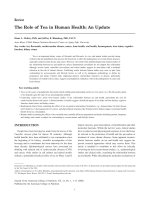The role of imaging in gastrointestinal bleed
Bạn đang xem bản rút gọn của tài liệu. Xem và tải ngay bản đầy đủ của tài liệu tại đây (495.71 KB, 32 trang )
The Role of Imaging in Gastrointestinal
Bleeding
Introduction
Common causes of GI bleeding
●
Upper gastrointestinal bleeding
●
Lower gastrointestinal bleeding
○
○
○
○
○
esophageal, gastric and duodenal ulcers
esophagitis, gastritis, duodenitis, pancreatitis
neoplasms
vascular malformations
varices
○
○
○
○
○
○
diverticulosis
post-polypectomy bleeding
ischemic colitis
colorectal polyps/neoplasms
inflammatory bowel disease
anorectal conditions
●
Small bowel bleeding
○
○
○
○
○
neoplasia
meckel’s diverticulum
polyposis syndromes
Angioectasia
NSAID ulcers
Nomenclature
●
●
●
●
Upper GI bleeding (UGIB): bleeding originating proximal to the Treitz ligament
Lower GI bleeding (LGIB): bleeding originating from the colon or rectum
Suspected small-bowel bleeding: the upper and lower GI tracts have been evaluated (typically with endoscopy) and no bleeding site
has been identified
Obscure GI bleeding: no bleeding source is found after the entire GI tract has been examined with advanced techniques
Radiologic imaging modalities of choice
Radiologic imaging modalities
●
●
●
●
Technetium 99m scintigraphy
Computed tomography angiography (CTA),
Multiphase computed tomography enterography (CTE)
Catheter angiography (CA)
Scintigraphy
●
Protocol
○
○
○
labeling the RBCs
intravascular injection
dynamic acquisition
●
Advantage
●
Disadvantages
○
○
○
○
Non-invasive
Detect slowest bleed
No bowel preparation required
Can detect intermittent bleed
○
○
○
Ionizing radiation and radiation dose
Non-therapeut
Not good for UGIB
●
Recommendation
○
all hemodynamically stable actively bleeding LGIB
Computed tomography angiography (CTA)
●
Protocols: without administration of oral contrast
○
○
○
initial non-contrast phase
identify pre-existing hyperdensities
arterial phase
hyperattenuating focus
portal venous phases
increase in size of hyperattenuating focus
slow or delayed bleed
■
■
■
■
Computed tomography angiography (CTA)
●
Advantages
●
Disadvantages
○
○
○
○
○
non-invasive, fast and readily available
identify cause even when not actively bleeding
can risk stratify patients
identify both arterial and venous bleeds and location
high sensitivity to detect active bleed
○
○
○
○
○
Ionizing radiation and radiation dose
contrast related side effects
intermittent bleeding may go undetected
non-therapeutic
not good for UGIB
Computed tomography angiography (CTA)
●
Recommendation
○
○
choice of modality for all hemodynamically stable actively bleeding LGIB
UGIB with negative endoscopy, or endoscopy not able to identify source
Multiphase computed tomography enterography (CTE)
●
Protocols
○
○
○
○
arterial phase (30 seconds)
enteric phase (50 seconds)
delayed phase (90–100 seconds)
small bowel lumen is distended with a bolus of a neutral oral contrast agent
allows optimal visualization of enhancement of the small bowel mucosa and wall => increase sensitivity
■
Multiphase computed tomography enterography (CTE)
●
Advantages
●
Disadvantages
○
○
○
detect source in obscure bleed
detect bowel pathologies even when not actively bleeding
evaluate bowel wall and abdominal vessels simultaneously
○
○
○
○
not good for acutely bleeding unstable patients
requires proper technique and good bowel distention
non-therapeutic
ionizating radiation
Multiphase computed tomography enterography (CTE)
●
Recommendation
○
○
initial diagnostic modality for LGI small bowel bleed with pre-existing bowel pathology
In patients with negative capsule endoscopy to look for small or large bowel source
Catheter angiography (CA)
●
Protocols
○
selective arterial catheterization
Catheter angiography (CA)
●
Advantages
●
Disadvantages
○
○
○
○
therapeutic interventions can also be performed
hemodynamically unstable patients
can localize exact site and cause
no bowel preparation required
○
○
○
○
embolization and vascular access site related side effects
ionizing radiation and contrast related side effects
cannot detect very slow bleed
poor performance in variable arterial anatomy
Catheter angiography (CA)
●
Recommendation
○
○
LGIB: initial modality of choice for hemodynamically unstable patients or recurrent/continuous bleeding after post colonoscopic treatment
UGIB: acutely bleeding patients with negative endoscopy or where endoscopy could not find source









